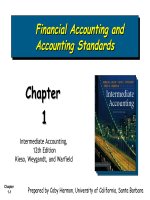Intermediate accounting 15e kieso warfield chapter 01
Bạn đang xem bản rút gọn của tài liệu. Xem và tải ngay bản đầy đủ của tài liệu tại đây (1.27 MB, 60 trang )
INTERMEDIATE
Intermediate
ACCOUNTING
Intermediate
Accounting
Accounting
F I F T E E N T H
1-1
E D I T I O N
Prepared
by
Prepared
by
Coby Harmon
Prepared by
Coby Harmon
Coby Harmon
University
of California
Santa Barbara
University
of California,
Santa Barbara
University of California, Santa Barbara
Westmont
College
Westmont
College
kieso
weygandt
warfield
team for success
PREVIEW OF CHAPTER
1
Intermediate Accounting
15th Edition
Kieso Weygandt Warfield
1-2
1
Financial Accounting and
Accounting Standards
LEARNING OBJECTIVES
After studying this chapter, you should be able to:
1-3
1.
Identify the major financial statements and
other means of financial reporting.
2.
Explain how accounting assists in the
efficient use of scarce resources.
6.
Explain the meaning of generally
accepted accounting principles (GAAP)
and the role of the Codification for GAAP.
7.
Describe the impact of user groups on
the rule-making process.
3.
Identify the objective of financial reporting.
4.
Explain the need for accounting standards.
8.
5.
Identify the major policy-setting bodies and
their role in the standard-setting process.
Describe some of the challenges facing
financial reporting.
9.
Understand issues related to ethics and
financial accounting.
Financial Statements and Reporting
Essential characteristics of accounting are:
(1) the identification, measurement, and communication
of financial information about
(2) economic entities to
(3) interested parties.
1-4
LO 1 Identify the major financial statements and other means of financial reporting.
Financial Statements and Reporting
Economic Entity
Financial Statements
Additional Information
Financial
Information
Balance Sheet
President’s letter
Income Statement
Prospectuses
Statement of Cash
Flows
Reports filed with
governmental
agencies
Accounting?
Identifies
and
Measures
and
Communicates
Statement of
Owners’ or
Stockholders’ Equity
Note Disclosures
GAAP
News releases
Forecasts
Environmental
impact statements
Etc.
1-5
LO 1 Identify the major financial statements and other means of financial reporting.
Financial Statements and Reporting
Question
What is the purpose of information presented in notes to the
financial statements?
1-6
a.
To provide disclosure required by generally accepted
accounting principles.
b.
To correct improper presentation in the financial statements.
c.
To provide recognition of amounts not included in the totals of
the financial statements.
d.
To present management’s responses to auditor comments.
LO 1 Identify the major financial statements and other means of financial reporting.
1
Financial Accounting and
Accounting Standards
LEARNING OBJECTIVES
After studying this chapter, you should be able to:
1-7
1.
Identify the major financial statements and
other means of financial reporting.
2.
Explain how accounting assists in the
efficient use of scarce resources.
6.
Explain the meaning of generally
accepted accounting principles (GAAP)
and the role of the Codification for GAAP.
7.
Describe the impact of user groups on
the rule-making process.
3.
Identify the objective of financial reporting.
4.
Explain the need for accounting standards.
8.
5.
Identify the major policy-setting bodies and
their role in the standard-setting process.
Describe some of the challenges facing
financial reporting.
9.
Understand issues related to ethics and
financial accounting.
Financial Statements and Reporting
Accounting and Capital Allocation
Resources are limited. Efficient use of resources often
determines whether a business thrives.
Illustration 1-1
Capital Allocation Process
1-8
LO 2 Explain how accounting assists in the efficient use of scare resources.
Accounting and Capital Allocation
Question
An effective process of capital allocation is critical to a healthy
economy, which
1-9
a.
promotes productivity.
b.
encourages innovation.
c.
provides an efficient and liquid market for buying and
selling securities.
d.
All of the above.
LO 2 Explain how accounting assists in the efficient use of scare resources.
IT’S THE ACCOUNTING
“It’s the accounting.” That’s what many investors seem to be saying these days.
Even the slightest hint of any accounting irregularity at a company leads to a
subsequent pounding of the company’s stock price. For example, the Wall Street
Journal has run the following headlines related to accounting and its effects on the
economy.
• Stocks take a beating as accounting woes spread beyond Enron.
• Quarterly reports from IBM and Goldman Sachs sent stocks tumbling.
• VeriFone finds accounting issues; stock price cut in half.
• Bank of America admits hiding debt.
• Facebook, Zynga, Groupon: IPO drops due to accounting, not valuation.
It now has become clear that investors must trust the accounting numbers, or they
will abandon the market and put their resources elsewhere. With investor
uncertainty, the cost of capital increases for companies who need additional
resources. In short, relevant and reliable financial information is necessary for
markets to be efficient.
1-10
LO 2 Explain how accounting assists in the efficient use of scare resources.
1
Financial Accounting and
Accounting Standards
LEARNING OBJECTIVES
After studying this chapter, you should be able to:
1-11
1.
Identify the major financial statements and
other means of financial reporting.
2.
Explain how accounting assists in the
efficient use of scarce resources.
6.
Explain the meaning of generally
accepted accounting principles (GAAP)
and the role of the Codification for GAAP.
7.
Describe the impact of user groups on
the rule-making process.
3.
Identify the objective of financial reporting.
4.
Explain the need for accounting standards.
8.
5.
Identify the major policy-setting bodies and
their role in the standard-setting process.
Describe some of the challenges facing
financial reporting.
9.
Understand issues related to ethics and
financial accounting.
Financial Statements and Reporting
Objectives of Financial Reporting
Provide financial information about the reporting entity that is
useful to
present and potential equity investors,
lenders, and
other creditors
in making decisions in their capacity as capital providers.
1-12
LO 3 Identify the objectives of financial reporting.
Objective of Financial Accounting
General-Purpose Financial Statements
Provide financial reporting information to a wide variety
of users.
Provide the most useful information possible at the
least cost.
Equity Investors and Creditors
1-13
Investors are the primary
user group.
LO 3 Identify the objectives of financial reporting.
Objective of Financial Accounting
Entity Perspective
Companies viewed as separate and distinct from their
owners.
Decision-Usefulness
Investors are interested in assessing the company’s
1. ability to generate net cash inflows and
2. management’s ability to protect and enhance the capital
providers’ investments.
1-14
LO 3 Identify the objectives of financial reporting.
DON’T FORGET STEWARDSHIP
In addition to providing decision-useful information about future cash flows,
management also is accountable to investors for the custody and safekeeping of
the company’s economic resources and for their efficient and profitable use. For
example, the management of The Hershey Company has the responsibility for
protecting its economic resources from unfavorable effects of economic factors,
such as price changes, and technological and social changes. Because Hershey’s
performance in discharging its responsibilities (referred to as its stewardship
responsibilities) usually affects its ability to generate net cash inflows, financial
reporting may also provide decision-useful information to assess management
performance in this role.
1-15
LO 3 Identify the objectives of financial reporting.
1
Financial Accounting and
Accounting Standards
LEARNING OBJECTIVES
After studying this chapter, you should be able to:
1-16
1.
Identify the major financial statements and
other means of financial reporting.
2.
Explain how accounting assists in the
efficient use of scarce resources.
6.
Explain the meaning of generally
accepted accounting principles (GAAP)
and the role of the Codification for GAAP.
7.
Describe the impact of user groups on
the rule-making process.
3.
Identify the objective of financial reporting.
4.
Explain the need for accounting standards.
8.
5.
Identify the major policy-setting bodies and
their role in the standard-setting process.
Describe some of the challenges facing
financial reporting.
9.
Understand issues related to ethics and
financial accounting.
The Need To Develop Standards
Various users
need financial
information
The accounting profession has
attempted to develop a set of
standards that are generally
accepted and universally
practiced.
1-17
Financial Statements
Balance Sheet
Income Statement
Statement of Stockholders’ Equity
Statement of Cash Flows
Note Disclosure
Generally Accepted
Accounting Principles
(GAAP)
LO 4 Explain the need for accounting standards.
1
Financial Accounting and
Accounting Standards
LEARNING OBJECTIVES
After studying this chapter, you should be able to:
1-18
1.
Identify the major financial statements and
other means of financial reporting.
2.
Explain how accounting assists in the
efficient use of scarce resources.
6.
Explain the meaning of generally
accepted accounting principles (GAAP)
and the role of the Codification for GAAP.
7.
Describe the impact of user groups on
the rule-making process.
3.
Identify the objective of financial reporting.
4.
Explain the need for accounting standards.
8.
5.
Identify the major policy-setting bodies and
their role in the standard-setting process.
Describe some of the challenges facing
financial reporting.
9.
Understand issues related to ethics and
financial accounting.
Parties Involved In Standard Setting
Three organizations:
1-19
Securities and Exchange Commission (SEC).
American Institute of Certified Public Accountants (AICPA).
Financial Accounting Standards Board (FASB).
LO 5 Identify the major policy-setting bodies and
their role in the standard-setting process.
Parties Involved In Standard Setting
Securities and Exchange Commission (SEC)
Established by federal government.
Accounting and reporting for public companies.
Securities
SecuritiesAct
Actof
of
1933
1933
1-20
Securities
SecuritiesAct
Actof
of
1934
1934
Encouraged private standard-setting body.
SEC requires public companies to adhere to GAAP.
SEC Oversight.
Enforcement Authority.
/>
LO 5 Identify the major policy-setting bodies and
their role in the standard-setting process.
Parties Involved In Standard Setting
American Institute of CPAs (AICPA)
National professional organization
Established the following:
/>
Committee on Accounting
Procedures
1-21
Accounting Principles
Board
1939 to 1959
1959 to 1973
Issued 51 Accounting Research
Bulletins (ARBs)
Issued 31 Accounting Principle
Board Opinions (APBOs)
Problem-by-problem approach
failed
Wheat Committee
recommendations adopted in
1973
LO 5
Parties Involved In Standard Setting
Financial Accounting Standards Board (FASB)
Wheat Committee’s recommendations resulted in creation of FASB.
Financial
Accounting
Foundation
Selects members of the FASB.
Funds their activities.
Exercises general oversight.
Financial
Accounting
Standards Board
Mission to establish and improve
standards of financial accounting
and reporting.
Consult on major policy issues.
Financial Accounting
Standards Advisory
Council
1-22
LO 5
Financial Accounting Standards Board
Missions is to establish and improve standards of financial
accounting and reporting. Differences between FASB and APB
include:
1-23
Smaller Membership.
Full-time, Remunerated Membership.
Greater Autonomy.
Increased Independence.
Broader Representation.
/>
LO 5 Identify the major policy-setting bodies and
their role in the standard-setting process.
Financial Accounting Standards Board
Question
The first step taken in the establishment of a typical FASB
statement is
1-24
a.
The board conducts research and analysis and a
discussion memorandum is issued.
b.
A public hearing on the proposed standard is held.
c.
The board evaluates the research and public response
and issues an exposure draft.
d.
Topics are identified and placed on the board’s agenda.
LO 5 Identify the major policy-setting bodies and
their role in the standard-setting process.
Financial Accounting Standards Board
Illustration 1-3
The Due Process
System of the
FASB
1-25
LO 5 Identify the major policy-setting bodies and
their role in the standard-setting process.









